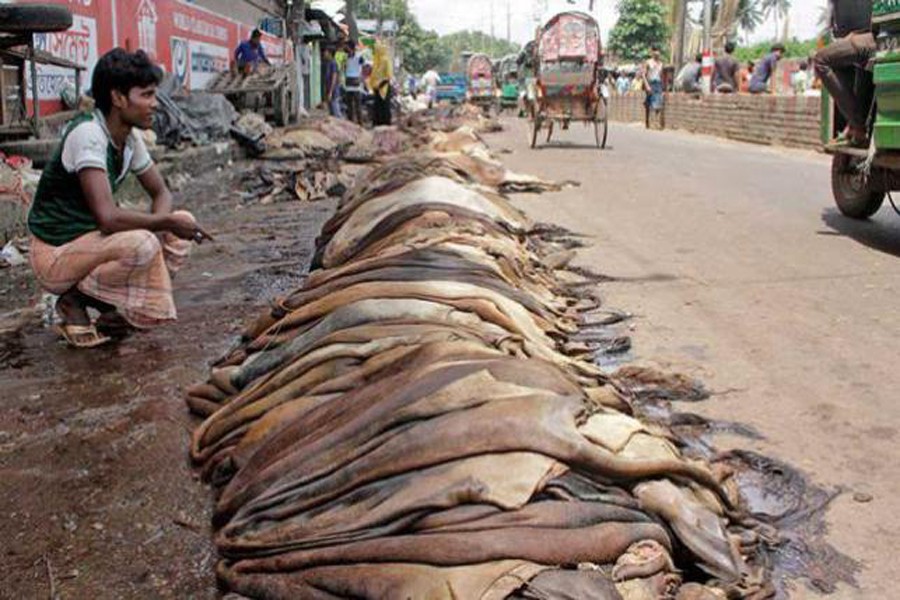Some people may feel tempted to describe the developments surrounding the prices of rawhide and skins of sacrificial animals this year as a scam. Some others, however, might disagree and find the use of the word 'scam' rather rash.
But what has happened with the prices of rawhide and skins on the occasion of this Eid-ul-Azha is unprecedented. Until 2016, the prices of rawhide and skins used to be more than the ones set by the Ministry of Commerce. During the last couple of years, the opposite had happened, with wholesale traders offering prices lower than those set by the government.
This year the slump in prices of rawhide and skins has been beyond any logic. A piece of rawhide of a sacrificial animal bought at a cost of Tk100,000 could fetch Tk 400 at best. Wholesale traders were found reluctant to buy goatskins in Dhaka. The situation was even worse in mufassil areas. There were virtually no buyers of the items.
Disgruntled small and seasonal traders and management of Madrashas and orphanages dumped an estimated 100,000 pieces of rawhide and goatskin in ponds, canals and underground across the country. In Chittagong small and seasonal traders dumped hundreds of pieces of rawhide on the streets failing to dispose those of. The Chittagong City Corporation (CCC) had faced a tough time removing those. It is estimated that nearly 10 to 15 per cent of rawhide and skins of sacrificial animals, valued at around Tk 1.0 billion, have been damaged on the occasion of this Eid.
Overall, the people have found the chaos over pricing and sale of rawhide and skins this year confusing and unacceptable.
The seasonal small traders or fariahs and religious institutions like Madrashas and orphanages were the most affected by the price-slump. The orphanages usually manage most part of their annual expenditure with the sale proceeds of rawhide and skins received as donations. This time these institutions would be facing a serious problem. The government should offer some help to the orphanages out of its safety net programme.
In the meanwhile, as it happens in most other cases, the relevant parties are pointing accusing fingers at each other.
The Commerce Minister held the traders responsible for the situation. The wholesale leather merchants blamed the tanners for the cash crunch. The former alleged that the tanners did not pay their dues against earlier purchases of rawhide and skins. However, the tanners dismissed the allegation, claiming that wholesale rawhide traders had enough money to do business.
However, it is widely suspected that what has happened with prices of rawhide and skins this year is more of an arranged game of both tanners and wholesale traders. During a meeting at the Ministry of Commerce (MoC), held on August 06 last, the tanners and rawhide wholesalers demanded that the rawhide prices be lowered, but the ministry set the trading prices at the last year's level.
The Finance Minister, however, said traders and tanners should have no reasons to face cash shortage for banks have sanctioned sufficient funds to them. He also questioned the suggestion that the government monitor prices of rawhide and skins. The MoC usually sets the prices of rawhide and skins ahead of Eid-ul-Azha celebration. When the government decides pricing of rawhide and skins, it is rather logical that the government would ensure that the price range is adhered to.
Amidst chaos over rawhide prices, the most puzzling development was the government decision to allow export of rawhide on August 13 last, the day following Eid-ul-Azha Though it was in the air for quite some time that the government might allow rawhide export again, the timing of the government decision took many by surprise.
There is no denying that the carryover wholesale traders do have a large stock of unsold rawhide and they need to dispose those of. But, in that case, the government announcement should have come before Eid. This could have buoyed up the market.
The tannery owners have demanded of the government to scrap the decision to export rawhide, alleging that the export would hurt the domestic leather industry.
Besides, the government does need to answer at least a couple of pertinent questions linked to its latest decision on rawhide export.
If the country is required to export rawhide again, what was the necessity of creating a large tannery industrial park at a huge cost? Why are the authorities concerned failing to complete the installation of the most-important ETP (effluent treatment plant)?
The completion of ETP would have helped the tanners to produce finished leather complying with the environmental requirements. Importers from the USA and the EU avoid Bangladesh leather goods on compliance issues. Local leather goods exporters have to import finished leather to meet compliance requirements. Last year, the country imported finished leather worth US$110 million when a large stock of rawhide and skins was rotting in local storages.


